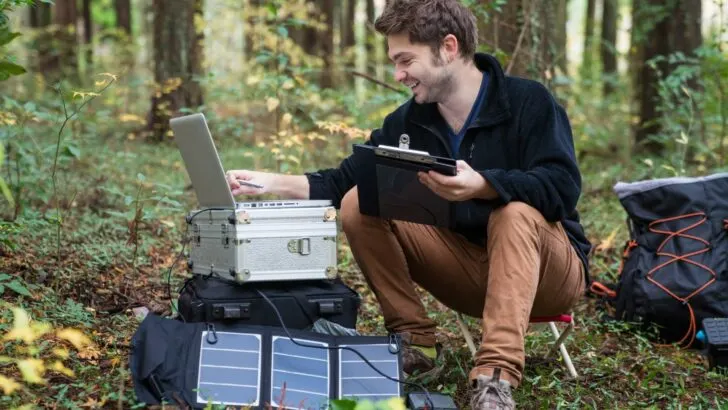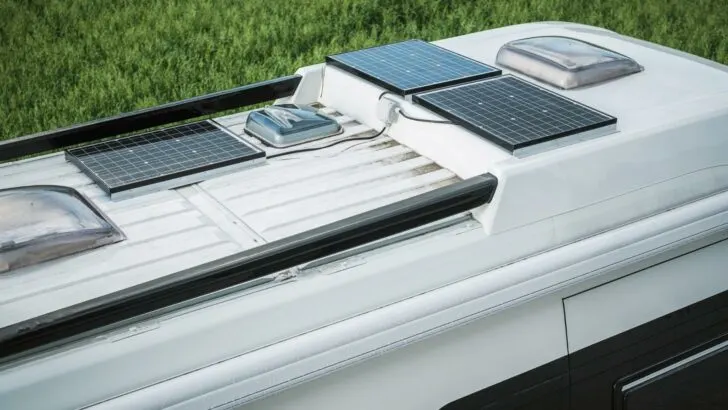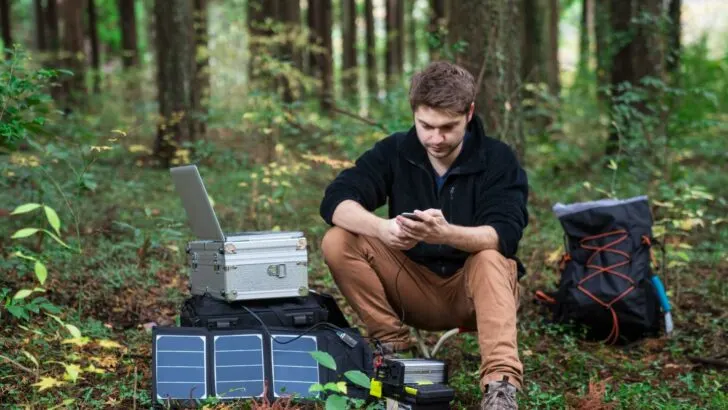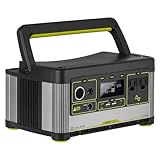Having lived and worked in our RV for close to two decades now, and being the avid boondockers we are, our move to solar was a big one: 600Ah of Lithium battery power, 8 solar panels (with 1,300 Watts of power), and a fully off-grid ready system. But not every RVer needs a system like ours, has the confidence to install one themselves, or wants to spend as much on all the upgrades needed. Instead, some travelers seek a simple, more portable system that would be just right for their needs. Enter the solar generator for RVs – portable power stations that will fit the bill for many.
Today’s post is a look at these awesome little systems that are not only compact and portable but can also take advantage of the power of the sun to fulfill the daily power requirements of RVers, campers, “van lifers”, and off-grid homes.
Welcome to the world of solar – all packed up in a nice little box. Let’s take a look inside!
- 1) What Is a Solar Generator for an RV?
- 2) What Is a Portable Power Station?
- 3) Why Would You Want a Solar Generator For Your RV?
- 4) What to Look For When Shopping For a Portable Power Station
- 5) 5 of the Best Solar Generators for Your RV
- 6) What Size Portable Power Station (Solar Generator) Do I Need for My RV?
What Is a Solar Generator for an RV?
A solar generator for an RV is a portable power station into which solar panels can be plugged to charge the system. Solar generators are versatile, compact, and combine the battery, solar charge controller, inverter, charger, and multiple charging ports all in one package, making them easy to move from place to place.
What Is a Portable Power Station?
A portable power station takes a battery (usually a lithium battery these days, but some people DIY their own portable power stations using lead-acid batteries), and combines it with the ports required for charging the battery as well as for powering external devices and appliances.
Portable power stations can be very small – small enough to fit into a pocket or backpack (this would be for the purpose of charging a cell phone, for example) – or they can be large enough to require some strength to move (this would be capable of powering appliances as hungry as microwaves, fridges, and more).
With everything built into one compact box, portable power stations can be charged by solar, 120-volt outlets (standard outlet in a home or hotel, for example), or by 12 volts supplied by a vehicle while driving.
These little power stations are versatile, compact, and portable.

A solar generator/portable power station can be completely or partially portable, depending on whether you install solar panels or use portable ones.
Why Would You Want a Solar Generator For Your RV?
Well, as we noted at the top of the post, a solar generator is great for travelers who have no need – or space or budget – for a very large solar system, or who don’t want to deal with the complications of installation. Building a solar system can be a daunting task, and taking into consideration the important factors such as Watts, amps, and volts and connecting everything within the system properly (and safely) can be a challenge not everyone is up to.
Also, some travelers only boondock occasionally or don’t use a lot of power. Or they may even be full-time travelers who don’t have the space for a large system and thus desire portability. Or maybe their RV didn’t come with an inverter (or a very large battery bank), but they want to be able to power their laptop and some other small 120V AC devices while on the road.
For all such travelers, the convenience of a solar generator is the perfect fit.
With a solar generator for your RV, you could power a 12V refrigerator, your phones, tablets, and computers, as well as other devices and appliances, depending on the size of the battery bank in your power station.
Along with the box containing the battery, solar charger, and inverter/charger, a portable solar panel or two can be placed outside the RV in sunny locations to recharge the portable power station.
So, there are many reasons why a traveler might want a solar generator for their RV.
Let’s run through some of the important things to consider when shopping for a portable power station/solar generator for an RV.

You can install solar panels on the roof of your RV, and those panels can power your solar generator or a permanently installed system.
What to Look For When Shopping For a Portable Power Station
When shopping for a solar generator or a portable power station of any kind, there are a number of features you’ll want to consider. Some of these are easy to forget about, and some buyers have been disappointed when they find that their portable power station doesn’t serve them in all the ways they’d hoped. Let’s take a look…
Capacity
The capacity of the battery bank built into your portable power station / solar generator is something that’s very important to consider from the outset. In order to assess the amount of power you’ll need so that you don’t fall short, you’ll want to add up all of the amp-hours you’ll tend to consume while boondocking, and you’ll want to buy a power station with sufficient amp hours to meet your needs.
Some travelers can get away with 80 amp-hours or even less, only wanting to charge phones, run a small fan, and maybe recharge a laptop once a day.
On the other hand, some people can have a battery bank with 600 amp-hours available and they still have to worry about having enough power to get through a day, particularly if they encounter several rainy or cloudy days and the sun is less available than the ideal (not that we know anyone like that, just sayin’ it COULD be possible! LOL!).

For those of us with very significant power needs, a solar generator is unlikely to be ideal.
So, understanding your desired (or required) power needs comes first, and then you’ll need to determine from there the battery capacity you’ll want in your solar generator / portable power station.
Inverter Rating
The calculations you make to determine the desired battery capacity of a solar generator for your RV will also serve to assist you in determining your inverter rating.
Portable power stations contain an inverter that converts the 12V power supplied by the built-in battery bank into usable 120V power for the purpose of powering devices and appliances that require standard household AC.
Inverters (power output) are rated in Watts, which are calculated using the formula:
Watts = (amps x volts)
Knowing this equation will help you to determine the inverter rating you’ll need. An inverter is rated in a certain number of Watts, but that rating is generally continuous.
For example, while your RV fridge might require only 180 Watts to run continuously, it may also require 600 Watts (just for a second) to start. Starting wattage needs to be factored into your calculations, otherwise, your inverter may not be sufficiently rated to start your fridge (or hairdryer, or coffee pot, etc.).
If you have a power-efficient 12V fridge, the calculations might be very different.
So, looking at the power you intend to consume is important in determining the rating of the inverter you’ll want in your solar generator/portable power station.
Charging Speed
Charging speed is very important and is a consideration often missed when consumers are shopping for a portable power station.
In addition to calculating how much power you’ll likely need in the course of a day or more, you’ll also need to know how quickly your portable power station can be recharged. You’ll want to consider how rapidly it’s rated to charge via solar panels as well as how long it takes to charge using the wall wart and a 120-volt receptacle (as well as from your vehicle’s battery/alternator if that’s an option with your solar generator).
If you run a CPAP machine all night and watch television to relax in the evening, and you charge your phones and tablets, and you run a fan all night, you need to know how long it will take the sun and your solar panel/panels to recharge your solar generator/portable power station.

If you have critical power needs such as the use of a CPAP machine, be sure to factor in those needs first when determining your power requirements. Remember to also consider that there will be some days when the sun produces less power than others.
Number & Type of Ports
How will you power and charge your devices and appliances? Do you need USB-A, USB-C, or both? Do you need 12V DC and 120V AC plugs, and if so, how many ports might you need at once?
If you’re going to plug a solar panel into your portable power station, you’d better be sure that power station is set up for solar. This means it will have a port that allows you to plug a panel into the station to recharge it, and will also have a built-in solar charge controller. This is what makes a portable power station a solar generator.
Some large solar generators even have 30-amp plugins (these are very large power stations that are also very expensive, but they do exist).
So, knowing the types of ports and how many of each you’ll need is important to your RV solar generator shopping criteria.
Display / Ease of Monitoring Status
A solar generator will often have an LCD monitor on it that allows you to keep an eye on your power consumption, how much power remains, how much charging power is going into the system at any given time, and more.
The ability to read and understand the display is very important to your experience as a solar generator user. Reviews are often the best way to assess this experience based on consumers who’ve used the system in a real-world setting.

The ability to monitor the power output and input is an important feature of any solar generator or portable power station.
Weight/Size
The weight and size of a portable solar generator for your RV is also important. A portable power station needs to be just that – portable. If you need to be able to move the power station, you’ll need to shop for one that has a weight you’re capable of lifting safely. (If you can’t lift a lot of weight but need more power, it’s possible to daisy-chain a couple of smaller power stations together, but you’ll need to add that capability to your shopping criteria as well.)
You also need a space in your RV where the station will sit, so consider that space before you shop.
Price
As always, budget is a consideration any time we make a purchase. Some solar power generators are priced well under $500, while some high-powered portable power stations cost well in excess of $5,000. Know your price point and shop accordingly, remembering that you can always upgrade in the future if your budget allows.
Pass-Through Charging
Pass-through charging means that the built-in battery of the portable power station can recharge while simultaneously charging a connected device or appliance.
Not all power stations or solar generators are set up to do this. They may be capable of being charged by solar power while powering a device, often at a slower rate. But when being charged through a wall socket, many will shut down power to all of the power ports while the power station itself is being recharged.
Pass-through charging requires a series of power regulating circuits that offer an amount of power required by a connected device that is consistent with the amps drawn from a wall socket.
If you need pass-through charging, you’ll want to make sure the portable power station you purchase is properly designed to do this.
5 of the Best Solar Generators for Your RV
Following are five of the best solar generators / portable power stations available on the market currently, specifically with RVers in mind.
Jackery Explorer 500
A very popular name in the solar generator/portable power station industry, Jackery makes several solar generators with various levels of power – 240W, 300W, 500W, 1000W, 1500W, and larger portable power stations and solar generators, all of which are great for RVers.
We’re highlighting the 500 for this post, but all of the Jackery power stations get excellent reviews. Which size you’d order would mostly depend on your power needs and your budget.
The Jackery 500 has a lithium-ion battery pack that offers 518 Watt-hours of power (40.5 amp-hours at 12.8V). It has a 500-Watt inverter with a 120-volt AC outlet to power your 120-volt appliances (500 Watts continuous with a 1000W peak to handle start-up/surge loads).
The Jackery 500 supports pass-through charging and a built-in battery management system. It offers three USB-A ports, and three 12V DC ports (one of which is a standard car-style port).
Roughly the size of a basketball and weighing 13.3 pounds, the Jackery Explorer 500 is easily transported with a sturdy handle that’s part of the casing of the Explorer.
Downsides? Well, it takes about 7.5 hours to charge this unit from an AC wall outlet, around 16 hours from your vehicle’s charging port, and roughly 9.5 hours from a 100-Watt solar panel (available through Jackery but sold separately). Note that the maximum recharge rate for the Explorer 500 is 100 Watts.
Also, Jackery doesn’t use lithium iron phosphate (LiFePO4) batteries, but rather lithium-ion NMC cells.
- LONG LASTING ENDURANCE: The Explorer 500 portable power station is built with the lithium-ion battery pack, in a safely designed frame structure to...
- SUPPORT PASS-THROUGH CHARGING: This power station features 1* AC outlet (110V 500W 1000W Peak), 3*USB-A ports, 2* DC ports, and 1*car port. Its...
Bluetti EB70S
Bluetti has quickly become a leading name in the solar generator industry with several high-quality portable power stations. Here we’re highlighting the EB70S which is an 800-Watt solar generator (with a peak output of 1400W), which is a great size for RVers.
Note that Bluetti also makes a smaller unit (EB55) as well as the larger AC200P and AC200MAX.
The EB70S has 12 outlets including four 120V AC outlets, two 100W USB-C ports, two USB-A ports, one regulated 12V car socket, two DC (12V) ports, and a wireless charging pad.
The EB70S has a maximum charging capacity of 200W either from an AC wall outlet or from solar panels. Bluetti claims it can be charged from 0 to 80% in only three hours, a claim largely supported by reviewers.
Bluetti includes a 24-month warranty, an AC adapter with charging cable, a car charging cable, and one solar charging cable (DC7909 to MC4).
Bluetti’s battery is a LiFePO4 with a built-in battery management system.
Note that the EB70S model is designed to charge devices and appliances under 800W. If you want to power hungrier appliances, you’ll want to consider one of Bluetti’s larger solar generators.
Bluetti sells solar panels separately.
- [Great Capacity to Size Ratio] - With 716Wh LFP cells and an 800W inverter, the EB70S weighing only 21.4lbs can power almost all your essentials on...
- [Power All Loads for the Road] - EB70S has everything you need in one unit, including 800W AC outlets/100W PD/USB-A/DC 5521/car port. A 15W wireless...
Goal Zero Yeti
One of the first solar generators to attract attention in the camping industry was the Goal Zero Yeti. Goal Zero makes a number of different sized solar generators as well as solar or lithium battery-powered accessories. From the smallest 150 Watt-hour unit, all the way up to a unit providing more than 6,000 Watt-hours of power, Goal Zero is meeting the needs of off-grid campers and homesteaders.
Today we’re highlighting the Goal Zero Yeti 500X for its reasonable price point and level of portability for campers and RVers.
The Yeti 500X offers 497 Watt-hours of power and weighs in at 12.9 pounds. It uses a 505Watt-hour lithium ion (NMC) battery and is capable of powering up to eight devices at once. Offering two USB-A ports, two USB-C ports (one being USB-C PD, capable of up to 60W), two 12V ports (one standard, one 6mm), and two 120V AC outlets, it should charge a smartphone around 40 times and a mini-fridge for up to 20 hours according to Goal Zero.
- Power. Anything. Anywhere. This power station’s 497 Watt Hours pack a punch. Complete your overlanding rig or prep for extended camping trips –...
- 7 Versatile Ports, 497 Wh Capacity: Power phones, WiFi routers, pellet grills and more with the Yeti 500X, which keeps devices running efficiently...
For higher power needs Goal Zero’s Yeti 1000 might better serve you with its 1000 Watt-hours. The price point is considerably higher, but it also has a lithium-ion battery and will charge from a 300W solar panel in around four hours (sunlight dependent!), nine hours from your 12V car charger (not included), and in nine hours from a wall outlet (also not included).
We’ll throw it in here as a bonus thanks to the lithium-ion battery, but do bear in mind that the cost is double that of the Yeti 500X, and solar panels are sold separately. In terms of portability, though, it doesn’t weigh much more than the Yeti 400.
- MAXIMUM CAPACITY: The 1000 Core powers most small and large appliances during an outage with a mighty 983Wh of capacity. Your TVs, full-size...
- VERSATILE AND PORTABLE: Fridges, electric barbecues, e-bikes, and more all stay powered with this portable power station. Keep everything running when...
EcoFlow Delta
Like the other manufacturers of solar generators we’ve looked at in this post, EcoFlow offers a variety of sizes of their solar generators from the 600W (Peak 1200W) River to the 2000W (5000W surge) Delta Max.
Again we’re looking at the middle child, the EcoFlow Delta, with its 1800W (3300W surge) and its multiple charging ports. This Delta unit offers 1,260 Watt-hours and features six AC (100V-120V) power outlets. It also has two USB-C ports, two USB-A ports, two USB-A fast-charging ports, and one standard DC (13.6V) port.
EcoFlow claims the Delta will recharge from 0% to 80% within one hour via an AC outlet and will accept solar input of up to 400W. It can be fully charged via a 12V DC car charger in 10-12 hours. EcoFlow notes that solar charge time depends on the input power of the panel itself plus weather conditions, angle of the panels, etc., and offers no additional information pertaining to solar charge times.
The EcoFlow Delta weighs 30.9 pounds.
- 0-80% in under 1 Hour. Ecoflow DELTA power station recharged at 10 times the speed of most portable power stations in the market with just a standard...
- Huge 1.2kWh Capacity. Portability doesn't have to sacrifice capacity. DELTA is a solar powered generator with a massive 1.2kWh capacity. Enough for...
RockPALS 300W Portable Power Station
For those with lower power needs, this little RockPALS 300 holds a 280 Watt-hour lithium-ion battery pack and enough power to charge phones, tablets, laptops, cameras, and small appliances.
It features a single 120V AC outlet (rated at 300W continuous output, 500W peak/surge), a single 12V car charging port, two DC ports (12V/5A, 60W max), two USB 3.1A ports, one QC 3.0 USB and one USB-C PD output (20V/1.5A, 30W max).
This little RockPALS 300 weighs just 7.70 pounds and may be just enough to serve the needs of a variety of campers and RVers. Reviews are excellent at 4.6 out of 5 stars from well over 1000 reviewers.
Note that RockPALS offers larger portable power stations as well.
- POWERFUL PORTABLE POWER STATION: The latest ROCKPALS 300 is equipped with 280wh (10.8V/26Ah) lithium-ion battery pack, has enough power to charge...
- MULTI FUNCTION OUTPUTS FOR CHOICE: Rockpals 300w portable power station features 1*pure since wave 110V AC outlets(300w rated, 500w peak); 1*car...
What Size Portable Power Station (Solar Generator) Do I Need for My RV?
The answer to this question depends entirely on how you intend to camp and what your power needs are. If you work or run a business (or several) as we do, your power needs will far exceed those of someone who simply wants to be able to charge a couple of cell phones and a tablet or laptop for watching a little entertainment while relaxing in the evenings. Many RVers fall somewhere in between those two need bases.
We suggest that you sit down and figure out what you need to power and for how long. Start with your most essential item (such as a CPAP machine) and work your way down. Once you’ve got an idea of the Watt-hours you’ll comfortably consume, you can move into shopping mode. Don’t forget to include items like fans that you may want to run through the night when the weather is hot.
No matter what your power needs are, there are several companies offering high-quality solar generators/portable power stations (and solar panels) that are capable of meeting those needs.
Geek Out With Us Every Week
Join our newsletter to learn about all things RV-related. Every week we offer free tips, tricks, product reviews, and more to our online community of RVers. So, whether this is your first time on the road or you’re a seasoned expert, we’d love for you to geek out with us!








Mark
Sunday 18th of September 2022
Yep solar works good as long as the sun is shinning bright, but when it's cloudy, raining, snowing or at night You will be thinking WHY don't I have a Reliable Gas powered Generator.
Tim Howlett
Saturday 8th of January 2022
Hey guys- thanks for the very informative article. Every time I read about solar options I keep thinking how much I’d like to dip my toe into the solar movement, especially since my wife and I are spending lots of time RVing in the sunny Southwest, and expect to do so again for the next few winters. However, given that we are living in a “classic” (aka old) 2005 class A motorcoach- with all of its original 2005 electrical wiring and components- I’m not sure I’m ready to commit to the cost and complexity of an integrated/hardwired solar setup. Furthermore, our main goal with solar would simply be to keep the coach batteries from discharging while boondocking over short periods (4-7 days) without needing to fire up the on board diesel generator. (Note: all 4 coach batteries are new, but unfortunately just standard deep cycle 12V lead acid). We use very modest amounts of power while boondocking- ie run the furnace/blowers a few times per day, use a few lights at night (all of which are LED) and maybe occasionally run a TV and DVD player off the inverter. Our fridge is not a residential unit and works fine on LP. SO…my question is this…would any of the solar generators reviewed in this article, along with a solar panel or two, work to essentially “trickle charge” my coach batteries if I were to simply plug my shore power cord into the power pack, (using the appropriate 50A to 30a to 20A adapters, of course) and then just diligently manage our current draw as if we were camping at a campground that only had a 20A power pedestal? Thanks for your thoughts and advice.
TheRVgeeks
Sunday 9th of January 2022
Hey Tim. Indeed, they can work that way... and, being portable, give you the ability to position the panels where they get the most sun. A couple of important points about the plan to use the solar generator to "trickle charge" your coach batters:
If you have a surge protector on your RV, like a Hughes Power Watchdog or Progressive Industries unit, you'll likely have an issue with them detecting a "No Ground" issue... and they'll stop the power altogether. You can ignore them, and just plug your RV in directly to the solar generator (if your surge protector can be unplugged from the flow), and you'll be fine. But if you have a hard-wired surge protector, you may not be able to bypass the protection. If possible, you'll likely want to ramp your charger's charge rate down as low as possible, to avoid taxing the solar generator.But... those things accounted for, YES! It would work. Though if you don't have need of the portable power capabilities of a unit like a solar generator, a small ground-deployed solar unit may suit your needs better (for less), keeping your onboard batteries topped up all day so you have power to make it through the night)